计算机网络实验报告——跨交换机实现VLAN
实验七 跨交换机实现VLAN间通信
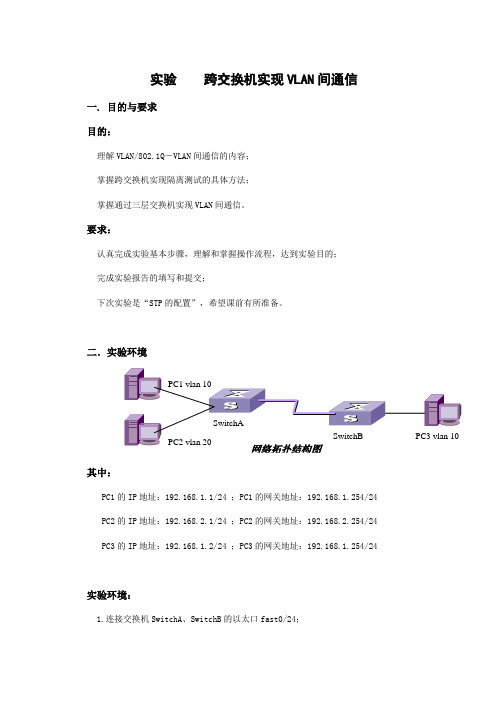
实验 跨交换机实现VLAN 间通信一. 目的与要求 目的:理解VLAN/802.1Q -VLAN 间通信的内容; 掌握跨交换机实现隔离测试的具体方法; 掌握通过三层交换机实现VLAN 间通信。
要求:认真完成实验基本步骤,理解和掌握操作流程,达到实验目的; 完成实验报告的填写和提交;下次实验是“STP 的配置”,希望课前有所准备。
二.实验环境其中:PC1的IP 地址:192.168.1.1/24 ;PC1的网关地址:192.168.1.254/24 PC2的IP 地址:192.168.2.1/24 ;PC2的网关地址:192.168.2.254/24 PC3的IP 地址:192.168.1.2/24 ;PC3的网关地址:192.168.1.254/24实验环境:1.连接交换机SwitchA 、SwitchB 的以太口fast0/24;PC2 vlan 20PC1 vlan 10SwitchA网络拓扑结构图PC3 vlan 10SwitchB2.将其中一交换机的fast0/5 和fast0/15 分别连接PC1和PC2,另一交换机的fast0/5 连接PC3。
三.实验流程1.尝试与交换机不同端口相连PC的连通性分别查看PC的IP地址;用Ping尝试其连通性,验证PC1与PC3 能互相通信,PC1与PC2也能互相通信; 思考:产生这样结果的原因。
2.配置交换机S3550-24,将其分成不同VLANSwitch# configure terminal注:进入交换机全局配置模式Switch(config)# hostname SwitchA注:给交换机起名SwitchASwitchA(config)# vlan 10注:创建vlan 10SwitchA(config-vlan)# name test10注:将Vlan 10 命名为test10SwitchA(config)# vlan 20注:创建vlan 20SwitchA(config-vlan)# name test20注:将Vlan 20 命名为test203.将与其相连的PC分别划归不同的VLAN SwitchA(config-if)# interface fastethernet 0/5 注:进入fastethernet 0/5 的接口配置模式SwitchA(config-if)# switch access vlan 10注:将fastethernet 0/5 端口加入vlan 10 中SwitchA(config-if)# interface fastethernet 0/15 注:进入fastethernet 0/15 的接口配置模式SwitchA(config-if)# switch access vlan 20注:将fastethernet 0/15 端口加入vlan 20 中SwitchA# show vlan注:显示交换机SwitchA vlan的划分4 .设置VLAN Trunk模式SwitchA(config-if)# interface fastethernet 0/24 注:进入fastethernet 0/24 的接口配置模式SwitchA(config-if)# switchport mode trunk注:将fastethernet 0/24 设为tag vlan 模式5 .配置交换机Switch,设置VLANSwitch# configure terminal注:进入交换机全局配置模式Switch(config)# hostname SwitchB注:给交换机起名SwitchASwitchB(config)# vlan 10注:创建vlan 10SwitchB(config-vlan)# name test10注:将Vlan 10 命名为test106 .将与其相连的PC划归VLANSwitchB(config-if)# interface fastethernet 0/5注:进入fastethernet 0/5 的接口配置模式SwitchB(config-if)# switch access vlan 10注:将fastethernet 0/5 端口加入vlan 10 中7.设置VLAN Trunk模式, 在交换机SwitchB 上将与SwitchA 相连的端口(假设为0/24 端口)定义为tag vlan 模式。
实验6 跨交换机实现VLAN
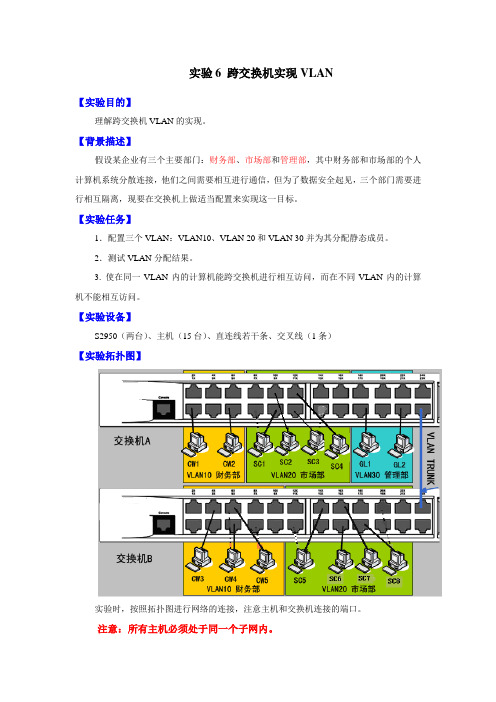
实验6 跨交换机实现VLAN【实验目的】理解跨交换机VLAN的实现。
【背景描述】假设某企业有三个主要部门:财务部、市场部和管理部,其中财务部和市场部的个人计算机系统分散连接,他们之间需要相互进行通信,但为了数据安全起见,三个部门需要进行相互隔离,现要在交换机上做适当配置来实现这一目标。
【实验任务】1.配置三个VLAN:VLAN10、VLAN 20和VLAN 30并为其分配静态成员。
2.测试VLAN分配结果。
3. 使在同一VLAN内的计算机能跨交换机进行相互访问,而在不同VLAN内的计算机不能相互访问。
【实验设备】S2950(两台)、主机(15台)、直连线若干条、交叉线(1条)【实验拓扑图】实验时,按照拓扑图进行网络的连接,注意主机和交换机连接的端口。
注意:所有主机必须处于同一个子网内。
交换机A 的端口23是干道接口;交换机B 的端口24是干道接口表1 表2【实验内容及步骤】准备工作:实验前应该先配置好主机的IP 地址、子网掩码和默认网关。
(10分)在未划VLAN 前测试15台PC 是否可以连通。
1、在交换机A 上创建三个VLAN :VLAN 10(名为“CWB ”)、VLAN 20(名为“SCB ”)、VLAN 30(名为“GLB ”)。
在交换机B 上创建两个VLAN :VLAN 10(名为“CWB ”)、VLAN 20(名为“SCB ”)。
(20分)2、按照表1将交换机A 上的端口1、5划分为VLAN10的成员,端口9~12划分为VLAN20的成员,端口17、21划分为VLAN30的成员。
(30分)3、按照表2将交换机B 上的端口4~6划分为VLAN 10的成员,端口14~17划分为VLAN 20的成员。
(20分)4、分别验证交换机A 、B 已创建的VLAN 及相应的端口划分。
SwitchA#show vlan //查看VLAN 的信息5、将交换机A 与交换机B 相连的端口(A 为0/23端口,B 为0/24端口)定义为tag vlan 模式(即主干道Trunk 模式),并分别设置两台交换机的Trunk 端口允许通过VLAN10 和VLAN20的流量。
跨交换机实现vlan路由
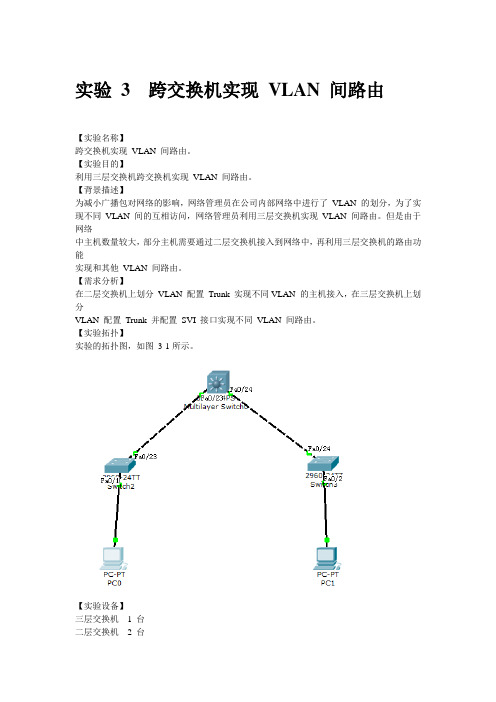
实验 3 跨交换机实现VLAN 间路由【实验名称】跨交换机实现VLAN 间路由。
【实验目的】利用三层交换机跨交换机实现VLAN 间路由。
【背景描述】为减小广播包对网络的影响,网络管理员在公司内部网络中进行了VLAN 的划分,为了实现不同VLAN 间的互相访问,网络管理员利用三层交换机实现VLAN 间路由。
但是由于网络中主机数量较大,部分主机需要通过二层交换机接入到网络中,再利用三层交换机的路由功能实现和其他VLAN 间路由。
【需求分析】在二层交换机上划分VLAN 配置Trunk 实现不同VLAN 的主机接入,在三层交换机上划分VLAN 配置Trunk 并配置SVI 接口实现不同VLAN 间路由。
【实验拓扑】实验的拓扑图,如图3-1所示。
【实验设备】三层交换机 1 台二层交换机 2 台PC 机 2 台【实验步骤】步骤 1 在SW1 中创建VLAN。
SW1(config)#vlan 10SW1(config-vlan)#vlan 20SW1(config-vlan)#exit截图步骤 2 在SW1 上给VLAN配置IP地址。
SW1(config)#interface vlan 10SW1(config-if)#ip address 192.168.10.1 255.255.255.0 SW1(config-if)#no shutdownSW1(config-if)#exitSW1(config)#interface vlan 20SW1(config-if)#ip address 192.168.20.1 255.255.255.0 SW1(config-if)#no shutdownSW1(config-if)#exit截图步骤 3 W1上配置Trunk。
SW1(config)#interface fastEthernet 0/23SW1(config-if)#switchport mode trunkSW1(config-if)#exitSW1(config)#interface fastEthernet 0/24SW1(config-if)#switchport mode trunkSW1(config-if)#exit截图步骤 4 在SW2 和SW3上创建相应的VLAN,并将端口划分到VLAN。
实验四 虚拟局域网--跨交换机实现VLAN
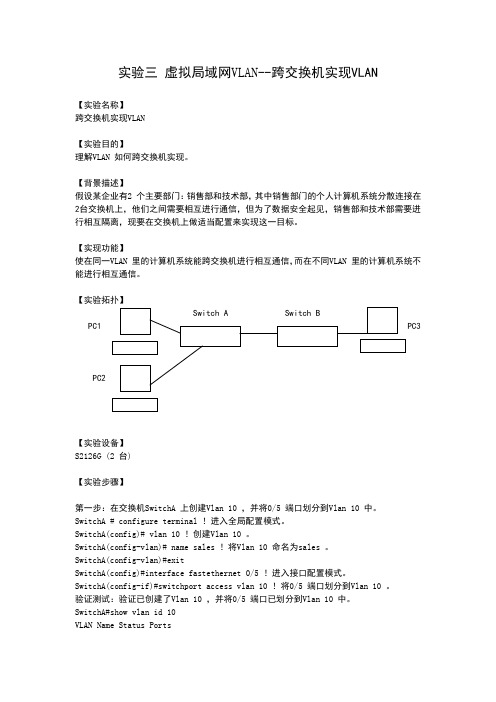
实验三虚拟局域网VLAN--跨交换机实现VLAN【实验名称】跨交换机实现VLAN【实验目的】理解VLAN 如何跨交换机实现。
【背景描述】假设某企业有2 个主要部门:销售部和技术部,其中销售部门的个人计算机系统分散连接在2台交换机上,他们之间需要相互进行通信,但为了数据安全起见,销售部和技术部需要进行相互隔离,现要在交换机上做适当配置来实现这一目标。
【实现功能】使在同一VLAN 里的计算机系统能跨交换机进行相互通信,而在不同VLAN 里的计算机系统不能进行相互通信。
【实验拓扑】【实验设备】S2126G (2 台)【实验步骤】第一步:在交换机SwitchA 上创建Vlan 10 ,并将0/5 端口划分到Vlan 10 中。
SwitchA # configure terminal !进入全局配置模式。
SwitchA(config)# vlan 10 !创建Vlan 10 。
SwitchA(config-vlan)# name sales !将Vlan 10 命名为sales 。
SwitchA(config-vlan)#exitSwitchA(config)#interface fastethernet 0/5 !进入接口配置模式。
SwitchA(config-if)#switchport access vlan 10 !将0/5 端口划分到Vlan 10 。
验证测试:验证已创建了Vlan 10 ,并将0/5 端口已划分到Vlan 10 中。
SwitchA#show vlan id 10VLAN Name Status Ports---- -------------------------------- --------- ------------------------------- 10 sales active Fa0/5第二步:在交换机SwitchA 上创建Vlan 20 ,并将0/15 端口划分到Vlan 20 中。
跨交换机划分vlan实验报告doc
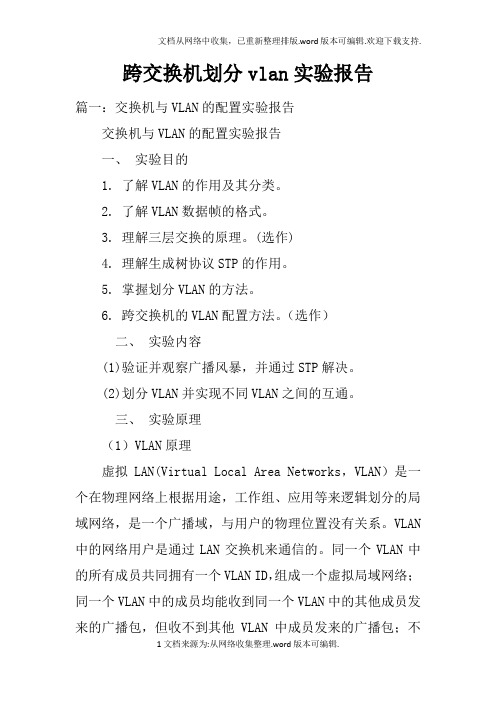
跨交换机划分vlan实验报告篇一:交换机与VLAN的配置实验报告交换机与VLAN的配置实验报告一、实验目的1. 了解VLAN的作用及其分类。
2. 了解VLAN数据帧的格式。
3. 理解三层交换的原理。
(选作)4. 理解生成树协议STP的作用。
5. 掌握划分VLAN的方法。
6. 跨交换机的VLAN配置方法。
(选作)二、实验内容(1)验证并观察广播风暴,并通过STP解决。
(2)划分VLAN并实现不同VLAN之间的互通。
三、实验原理(1)VLAN原理虚拟LAN(Virtual Local Area Networks,VLAN)是一个在物理网络上根据用途,工作组、应用等来逻辑划分的局域网络,是一个广播域,与用户的物理位置没有关系。
VLAN 中的网络用户是通过LAN交换机来通信的。
同一个VLAN中的所有成员共同拥有一个VLAN ID,组成一个虚拟局域网络;同一个VLAN中的成员均能收到同一个VLAN中的其他成员发来的广播包,但收不到其他VLAN中成员发来的广播包;不同VLAN成员之间不可直接通信,需要通过路由支持才能通信,而同一VLAN中的成员通过VLAN交换机可以直接通信,不需路由支持。
(2)VLAN间通信①MAC地址静态登记方式②帧标签方式③虚连接方式④路由方式(3)VLAN交换机的互联接入链路;中继链路;混合链路四、实验环境Quidway S3928 一台,Quidway S2403一台,计算机4台,Cosole线4条,标准网线6根五、实验步骤1、按照上图连接设备,为交换机划分VLAN。
命令为:sysSystem View: return to User View with Ctrl+Z.[Quidway]sysname S1[S1]vlan 2[S1-vlan2]port e 0/1 to e 0/5[S1-vlan2]vlan 3[S1-vlan3]port e 0/3 to e 0/7[S1-vlan3]q2、设置各台pc机的ip地址,分别为:Pca:192.168.10.9 pcb:192.168.10.1 pcc:192.168.10.3 pcd:192.168.10.43、验证同一VLAN中的两台计算机能否通信,不同计算机之间的计算机能否通信,并将结果记录在表3-1中。
实验1-跨交换机vlan配置
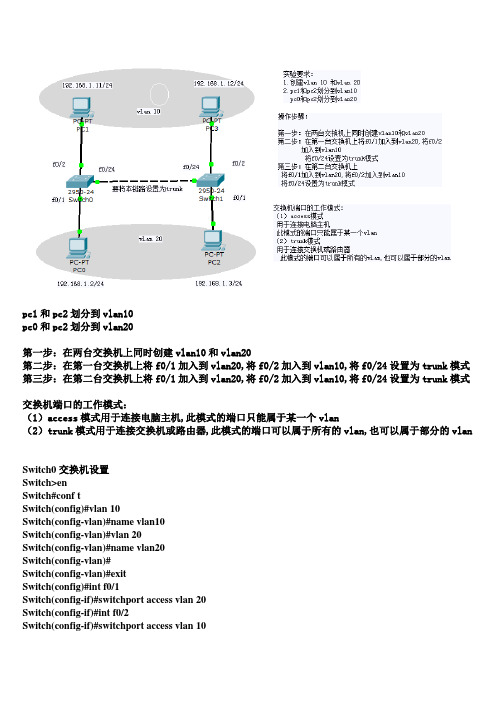
pc1和pc2划分到vlan10pc0和pc2划分到vlan20第一步:在两台交换机上同时创建vlan10和vlan20第二步:在第一台交换机上将f0/1加入到vlan20,将f0/2加入到vlan10,将f0/24设置为trunk模式第三步:在第二台交换机上将f0/1加入到vlan20,将f0/2加入到vlan10,将f0/24设置为trunk模式交换机端口的工作模式:(1)access模式用于连接电脑主机,此模式的端口只能属于某一个vlan(2)trunk模式用于连接交换机或路由器,此模式的端口可以属于所有的vlan,也可以属于部分的vlan Switch0交换机设置Switch>enSwitch#conf tSwitch(config)#vlan 10Switch(config-vlan)#name vlan10Switch(config-vlan)#vlan 20Switch(config-vlan)#name vlan20Switch(config-vlan)#Switch(config-vlan)#exitSwitch(config)#int f0/1Switch(config-if)#switchport access vlan 20Switch(config-if)#int f0/2Switch(config-if)#switchport access vlan 10Switch(config-if)#int f0/24Switch(config-if)#switchport mode trunk Switch#show vlanSwitch1交换机设置Switch>enSwitch#conf tSwitch(config)#vlan 10Switch(config-vlan)#name vlan10Switch(config-vlan)#vlan 20Switch(config-vlan)#name vlan20Switch(config-vlan)#exitSwitch(config)#int f0/1Switch(config-if)#switchport access vlan 20 Switch(config-if)#int f0/2Switch(config-if)#switchport access vlan 10 Switch#show vlanPC0 ping PC1 不能ping通PC0 ping PC2 能ping通。
实验09 跨交换机实现VLAN
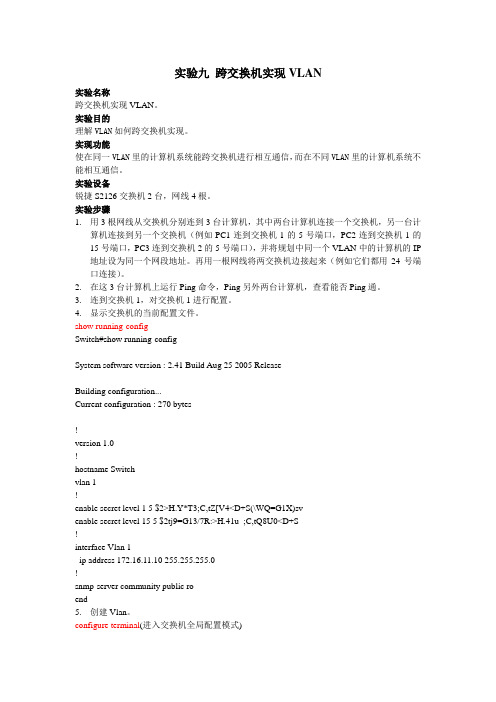
实验九跨交换机实现VLAN实验名称跨交换机实现VLAN。
实验目的理解VLAN如何跨交换机实现。
实现功能使在同一VLAN里的计算机系统能跨交换机进行相互通信,而在不同VLAN里的计算机系统不能相互通信。
实验设备锐捷S2126交换机2台,网线4根。
实验步骤1.用3根网线从交换机分别连到3台计算机,其中两台计算机连接一个交换机,另一台计算机连接到另一个交换机(例如PC1连到交换机1的5号端口,PC2连到交换机1的15号端口,PC3连到交换机2的5号端口),并将规划中同一个VLAN中的计算机的IP 地址设为同一个网段地址。
再用一根网线将两交换机边接起来(例如它们都用24号端口连接)。
2.在这3台计算机上运行Ping命令,Ping另外两台计算机,查看能否Ping通。
3.连到交换机1,对交换机1进行配置。
4.显示交换机的当前配置文件。
show running-configSwitch#show running-configSystem software version : 2.41 Build Aug 25 2005 ReleaseBuilding configuration...Current configuration : 270 bytes!version 1.0!hostname Switchvlan 1!enable secret level 1 5 $2>H.Y*T3;C,tZ[V4<D+S(\WQ=G1X)svenable secret level 15 5 $2tj9=G13/7R:>H.41u_;C,tQ8U0<D+S!interface Vlan 1ip address 172.16.11.10 255.255.255.0!snmp-server community public roend5.创建Vlan。
configure terminal(进入交换机全局配置模式)vlan 2 (创建一个Vlan,编号为2)name vlan2(设置这个Vlan的名称为Vlan2)exitvlan 3 (创建一个Vlan,编号为3)name vlan3(设置这个Vlan的名称为Vlan3)exit6.show vlan(显示本机的Vlan信息)miaochuan#show vlanVLAN Name Status Ports---- -------------------------------- --------- --------------------1 default active Fa0/1 ,Fa0/2 ,Fa0/3Fa0/5 ,Fa0/6 ,Fa0/7Fa0/9 ,Fa0/10,Fa0/11Fa0/13,Fa0/14,Fa0/15Fa0/17,Fa0/18,Fa0/19Fa0/21,Fa0/22,Fa0/232 vlan2 active3 vlan3 activemiaochuan#7.将不同的交换机端口分配到Vlan中configure terminal(进入交换机全局配置模式)interface fastethernet 0/5(进入5号端口)Switch access vlan 2(将5号端口加入到Vlan 2中)ExitInterface fastethernet 0/10(进入10号端口)Switch access vlan 3(将10号端口加入到Vlan 3中)Exitinterface fastethernet 0/24(进入24号端口)switch mode trunk(将交换机1的24号端端口设为trunk模式)8.显示交换机的当前配置文件。
【实验】跨交换机划分vlan实验报告
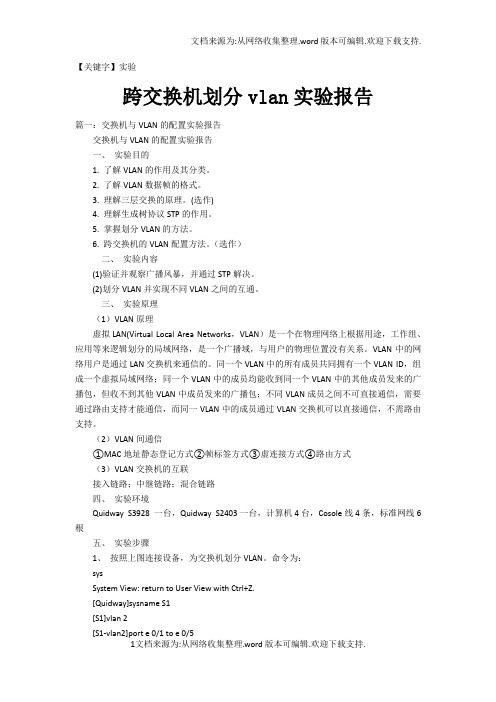
【关键字】实验跨交换机划分vlan实验报告篇一:交换机与VLAN的配置实验报告交换机与VLAN的配置实验报告一、实验目的1. 了解VLAN的作用及其分类。
2. 了解VLAN数据帧的格式。
3. 理解三层交换的原理。
(选作)4. 理解生成树协议STP的作用。
5. 掌握划分VLAN的方法。
6. 跨交换机的VLAN配置方法。
(选作)二、实验内容(1)验证并观察广播风暴,并通过STP解决。
(2)划分VLAN并实现不同VLAN之间的互通。
三、实验原理(1)VLAN原理虚拟LAN(Virtual Local Area Networks,VLAN)是一个在物理网络上根据用途,工作组、应用等来逻辑划分的局域网络,是一个广播域,与用户的物理位置没有关系。
VLAN中的网络用户是通过LAN交换机来通信的。
同一个VLAN中的所有成员共同拥有一个VLAN ID,组成一个虚拟局域网络;同一个VLAN中的成员均能收到同一个VLAN中的其他成员发来的广播包,但收不到其他VLAN中成员发来的广播包;不同VLAN成员之间不可直接通信,需要通过路由支持才能通信,而同一VLAN中的成员通过VLAN交换机可以直接通信,不需路由支持。
(2)VLAN间通信①MAC地址静态登记方式②帧标签方式③虚连接方式④路由方式(3)VLAN交换机的互联接入链路;中继链路;混合链路四、实验环境Quidway S3928 一台,Quidway S2403一台,计算机4台,Cosole线4条,标准网线6根五、实验步骤1、按照上图连接设备,为交换机划分VLAN。
命令为:sysSystem View: return to User View with Ctrl+Z.[Quidway]sysname S1[S1]vlan 2[S1-vlan2]port e 0/1 to e 0/5[S1-vlan2]vlan 3[S1-vlan3]port e 0/3 to e 0/7[S1-vlan3]q2、设置各台pc机的ip地址,分别为:Pca: pcb: pcc: pcd:3、验证同一VLAN中的两台计算机能否通信,不同计算机之间的计算机能否通信,并将结果记录在表3-1中。
跨交换机VLAN及VLAN之间通信实验报告

实验二 跨交换机VLAN 及VLAN 之间通信【实验名称】 跨交换机vlan 及vlan 之间通信 【实验类型】 验证性实验 【实验学时】 2学时 【实验目的】1.实现跨交换机的VLAN2.掌握三层交换机实现不同VLAN 之间互通的方法 【基本原理】实现跨交换机的VLAN 需要采用IEEE802.1q 协议的标准,在交换机之间的trunk 链路中传输的数据帧内被添加了4个字节的802.1q 标签信息,用于标识该数据帧属于哪个VLAN ,以便于对端交换机接收到数据帧后进行准确的过滤。
一、 实现跨交换机的VLAN 【基本原理】跨交换机的VLAN ,就是由多个交换机的端口组成一个VLAN ,一组互相连接的交换机中VLAN 号相同的一组VLAN 可以构成一个跨交换机的VLAN 或多交换机的VLAN ,该VLAN 内主机之间可以在第二层直接通信,同时对于不同VLAN 的主机进行隔离。
实现跨交换机的VLAN 需要采用IEEE802.1q 协议,在交换机之间的链路被设置为trunk 链路,在trunk 链路中传输的数据帧内被添加了4个字节的802.1q 标签(Tag)信息,用于标识该数据帧属于哪个VLAN ,以便于对端交换机接收到数据帧后进行准确的过滤,所以跨交换机VLAN 也称为Tag Vlan 。
为了实现Tag Vlan ,二台交换机互相连接的端口要设置成trunk 模式(交换机所有的端口在默认情况下属于ACCESS 端口),Trunk 端口在默认情况下支持所有VLAN 的传输。
假设某企业有两个主要部门:销售部和技术部,其中销售部门的计算机连接在不同的交换机上,他们之间需要通信,但为了数据安全起见,销售部和技术部需要进行相互隔离,可以在交换机上做适当配置来实现这一目标。
【实验内容】构建网络,建立站点分布在二台交换机的VLAN 。
【实验网络拓扑】192.168.1.1F0/24 F0/5F0/5VLAN 1交换机S3VLAN 1 192.168.1.3F0/24 VLAN 2 192.168.5.1H3 H1H22950-24 F0/15交换机S22950-24图 2实验前规划网络拓扑,画出拓扑图,实验时,按照拓扑图进行网络的连接。
实验四 跨交换机实现VLAN
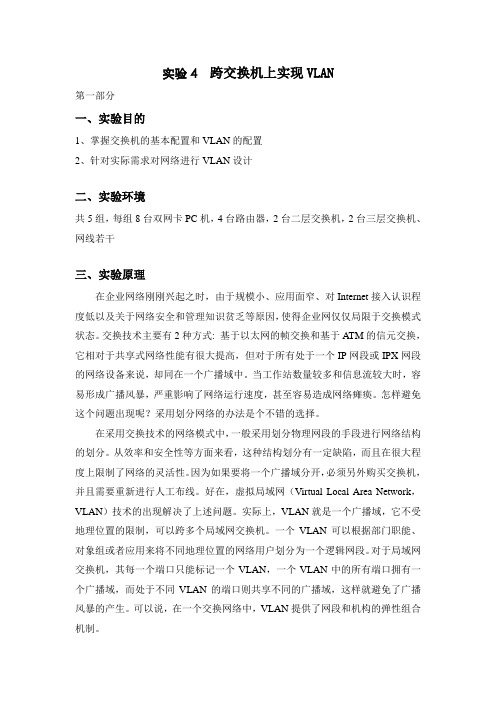
实验4 跨交换机上实现VLAN第一部分一、实验目的1、掌握交换机的基本配置和VLAN的配置2、针对实际需求对网络进行VLAN设计二、实验环境共5组,每组8台双网卡PC机,4台路由器,2台二层交换机,2台三层交换机、网线若干三、实验原理在企业网络刚刚兴起之时,由于规模小、应用面窄、对Internet接入认识程度低以及关于网络安全和管理知识贫乏等原因,使得企业网仅仅局限于交换模式状态。
交换技术主要有2种方式: 基于以太网的帧交换和基于ATM的信元交换,它相对于共享式网络性能有很大提高,但对于所有处于一个IP网段或IPX网段的网络设备来说,却同在一个广播域中。
当工作站数量较多和信息流较大时,容易形成广播风暴,严重影响了网络运行速度,甚至容易造成网络瘫痪。
怎样避免这个问题出现呢?采用划分网络的办法是个不错的选择。
在采用交换技术的网络模式中,一般采用划分物理网段的手段进行网络结构的划分。
从效率和安全性等方面来看,这种结构划分有一定缺陷,而且在很大程度上限制了网络的灵活性。
因为如果要将一个广播域分开,必须另外购买交换机,并且需要重新进行人工布线。
好在,虚拟局域网(Virtual Local Area Network,VLAN)技术的出现解决了上述问题。
实际上,VLAN就是一个广播域,它不受地理位置的限制,可以跨多个局域网交换机。
一个VLAN可以根据部门职能、对象组或者应用来将不同地理位置的网络用户划分为一个逻辑网段。
对于局域网交换机,其每一个端口只能标记一个VLAN,一个VLAN中的所有端口拥有一个广播域,而处于不同VLAN的端口则共享不同的广播域,这样就避免了广播风暴的产生。
可以说,在一个交换网络中,VLAN提供了网段和机构的弹性组合机制。
由于网络规模不断扩大,信息流量逐渐加大,人员管理变得日益复杂,给企业网的安全、稳定和高效运行带来新的隐患,如何消除这些隐患呢?VLAN划分技术能为此排忧解难。
通常,一个规模较大的企业,其下属一般拥有多个二级单位,为保证对不同职能部门管理的方便性和安全性以及整体网络运行的稳定性,可以采用VLAN划分技术,进行虚拟网络划分。
计算机网络实验 实验四 跨交换机实现vlan

实验八 网络地址转换
实验名称:静态内部源地址转换NAT 实验目的:掌握内网中一台服务器连接到Internet网时的静态内部源地址 转换
步骤1:基本配置 Red-Giant(config)#hostname R1 R1(config)#interface serial 1/2 R1(config-if)# ip address 192.1.1.1 255.255.255.0 R1(config-if)# clock rate 64000 R1(config-if)# no shutdown R1(config-if)# end R1(config)# interface fa 1/0 R1(config-if)# ip add 192.168.1.1 255.255.255.0 R1(config-if)# no sh
跨交换机实现VLAN
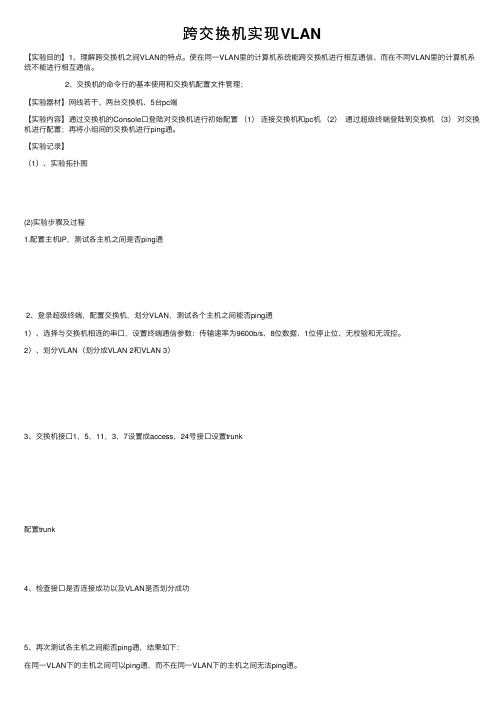
跨交换机实现VLAN
【实验⽬的】1、理解跨交换机之间VLAN的特点。
使在同⼀VLAN⾥的计算机系统能跨交换机进⾏相互通信、⽽在不同VLAN⾥的计算机系统不能进⾏相互通信。
2、交换机的命令⾏的基本使⽤和交换机配置⽂件管理;
【实验器材】⽹线若⼲、两台交换机、5台pc端
【实验内容】通过交换机的Console⼝登陆对交换机进⾏初始配置(1)连接交换机和pc机(2)通过超级终端登陆到交换机(3)对交换机进⾏配置;再将⼩组间的交换机进⾏ping通。
【实验记录】
(1)、实验拓扑图
(2)实验步骤及过程
1.配置主机IP,测试各主机之间是否ping通
2、登录超级终端,配置交换机,划分VLAN,测试各个主机之间能否ping通
1)、选择与交换机相连的串⼝,设置终端通信参数:传输速率为9600b/s、8位数据、1位停⽌位、⽆校验和⽆流控。
2)、划分VLAN(划分成VLAN 2和VLAN 3)
3、交换机接⼝1,5,11,3,7设置成access,24号接⼝设置trunk
配置trunk
4、检查接⼝是否连接成功以及VLAN是否划分成功
5、再次测试各主机之间能否ping通,结果如下:
在同⼀VLAN下的主机之间可以ping通,⽽不在同⼀VLAN下的主机之间⽆法ping通。
成功!。
实验二跨交换机实现VLAN利用三层交换机实现VLAN间路由
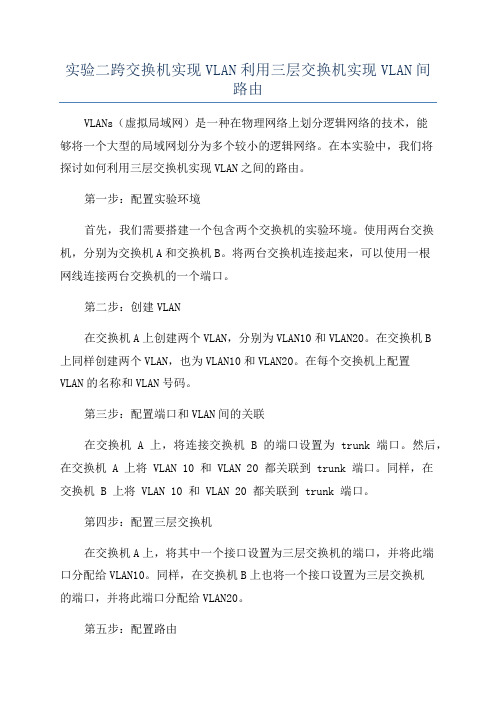
实验二跨交换机实现VLAN利用三层交换机实现VLAN间路由VLANs(虚拟局域网)是一种在物理网络上划分逻辑网络的技术,能够将一个大型的局域网划分为多个较小的逻辑网络。
在本实验中,我们将探讨如何利用三层交换机实现VLAN之间的路由。
第一步:配置实验环境首先,我们需要搭建一个包含两个交换机的实验环境。
使用两台交换机,分别为交换机A和交换机B。
将两台交换机连接起来,可以使用一根网线连接两台交换机的一个端口。
第二步:创建VLAN在交换机A上创建两个VLAN,分别为VLAN10和VLAN20。
在交换机B上同样创建两个VLAN,也为VLAN10和VLAN20。
在每个交换机上配置VLAN的名称和VLAN号码。
第三步:配置端口和VLAN间的关联在交换机 A 上,将连接交换机 B 的端口设置为 trunk 端口。
然后,在交换机 A 上将 VLAN 10 和 VLAN 20 都关联到 trunk 端口。
同样,在交换机 B 上将 VLAN 10 和 VLAN 20 都关联到 trunk 端口。
第四步:配置三层交换机在交换机A上,将其中一个接口设置为三层交换机的端口,并将此端口分配给VLAN10。
同样,在交换机B上也将一个接口设置为三层交换机的端口,并将此端口分配给VLAN20。
第五步:配置路由在交换机A上,配置路由,将VLAN10和VLAN20进行路由。
在交换机B上也需要进行同样的配置。
第六步:测试现在可以测试VLAN之间的路由是否成功。
连接两台主机至交换机A 的接口和交换机B的接口,确保每台主机都在不同的VLAN中。
在主机A上,配置IP地址为VLAN10子网的IP地址,如192.168.10.2、在主机B上,配置IP地址为VLAN20子网的IP地址,如192.168.20.2然后尝试从主机 A ping 主机 B,如果能够成功得到回应,则表示VLAN 之间的路由成功实现。
总结:在本实验中,我们使用两个交换机和一个三层交换机搭建了一个VLAN间路由的环境。
跨交换机vlan实验报告
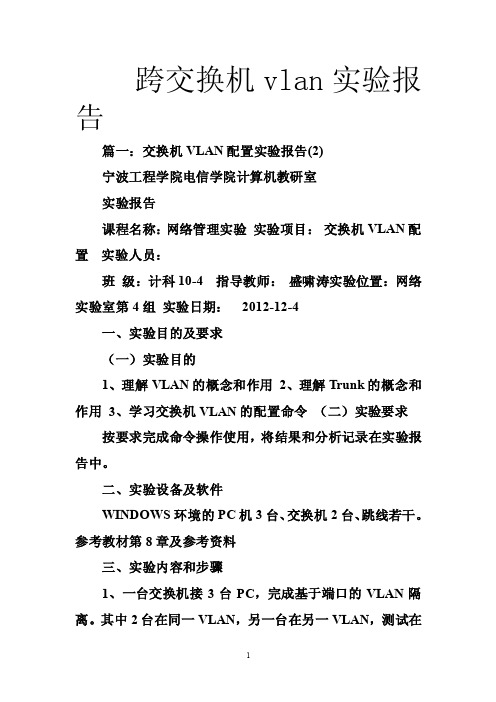
跨交换机vlan实验报告篇一:交换机VLAN配置实验报告(2)宁波工程学院电信学院计算机教研室实验报告课程名称:网络管理实验实验项目:交换机VLAN配置实验人员:班级:计科10-4 指导教师:盛啸涛实验位置:网络实验室第4组实验日期:2012-12-4一、实验目的及要求(一)实验目的1、理解VLAN的概念和作用2、理解Trunk的概念和作用3、学习交换机VLAN的配置命令(二)实验要求按要求完成命令操作使用,将结果和分析记录在实验报告中。
二、实验设备及软件WINDOWS环境的PC机3台、交换机2台、跳线若干。
参考教材第8章及参考资料三、实验内容和步骤1、一台交换机接3台PC,完成基于端口的VLAN隔离。
其中2台在同一VLAN,另一台在另一VLAN,测试在隔离前3台可通信,隔离后同一VLAN可通信,不同VLAN 不可通信。
PC1SwitchAPC3192.168.1.1;vlan 20192.168.1.3;vlan 10PC2192.168.1.2;vlan 202、利用Trunk实现跨交换机的基于端口的VLAN隔离。
PC1SwitchASwitchBPC2192.168.1.1;192.168.1.2;vlan 10PC3192.168.1.3;vlan 20PC4192.168.1.4;vlan 203、show命令显示配置结果并进行分析【实验基础知识】VLAN的定义:究竟什么是VLAN呢? VLAN(Virtual Local Area Network)即虚拟局域网,是一种通过将局(转载自: 蓬勃范文网:跨交换机vlan实验报告)域网内的设备逻辑地而不是物理地划分成一个个网段从而实现虚拟工作组的新兴技术。
IEEE于1999年颁布了用以标准化VLAN实现方案的802.1Q协议标准草案。
VLAN技术允许网络管理者将一个物理的LAN逻辑地划分成不同的广播域(或称虚拟LAN,即VLAN),每一个VLAN都包含一组有着相同需求的计算机工作站,与物理上形成的LAN有着相同的属性。
昆明理工大学津桥学院《计算机网络》跨交换机实现VLAN实验报告

昆明理工大学津桥学院《计算机网络》跨交换机实现VLAN实验报告课程名称实验项目跨交换机实现VLAN 专业班级姓名学号指导教师成绩日期一、实验目的理解VLAN的概念,熟悉交换机配置命令,学会跨交换机实现VLAN的配置方法。
二、实验设备和环境Windows操作系统,Cisco Packet Tracer(两台交换机、四台主机、四条直连线、一条虚线)。
三、实验内容1、画出实验拓扑图;2、配置主机IP,测试各主机之间是否ping通;3、配置交换机,划分VLAN,测试各主机之间是否ping通。
四、实现功能及原理使在同一VLAN里的计算机系统能跨交换机进行相互通信,而在不同VLAN里的计算机系统不能进行相互通信。
两台交换机之间使用f0/1端口相连,交换机switch0连接PC0和PC1,交换机switch1连接PC2和PC3。
将PC0和PC2设为VLAN10,PC1和PC3设为VLAN20。
划分VLAN之前,四台计算机之间都可以相互通信,即能够ping通。
划分VLAN之后,只有同一个VLAN中的计算机能够通信(即能ping通),不同VLAN之间的计算机不能通信(即不能ping通)。
跨交换机划分VLAN的实验拓扑图如下:五、实验过程(一)实验拓扑:(二)实验步骤1、在Packet Tracer软件中,画好网络拓扑图,给四台计算机分别配置好IP地址。
各计算机的IP地址配置如下表:VLAN 计算机IP地址子网掩码VLAN10 PC0 192.168.1.11 255.255.255.0 PC1 192.168.1.12 255.255.255.0VLAN20 PC2 192.168.1.13 255.255.255.0 PC3 192.168.1.14 255.255.255.02、在四台计算机上分别使用ping命令,确认它们之间全部能够相互通信。
通过实验可得四台计算机能够相互通信(如图所示)3、将两台交换机改名称如下:Switch>enableSwitch#configure terminalEnter configuration commands, one per line. End with CNTL/Z.Switch(config)#hostname switchA //将交换机名称改为swichAswitchA(config)#Switch>enableSwitch#configure terminalEnter configuration commands, one per line. End with CNTL/Z.Switch(config)#hostname switchB //将交换机名称改为swichBswitchB(config)#4、在交换机switchA上划分vlan 10 和vlan 20:switchA(config)#vlan 10switchA(config-vlan)#name vlan10switchA(config-vlan)#exitswitchA(config)#vlan 20switchA(config-vlan)#name vlan20switchA(config-vlan)#exit5、在交换机switchA上将f0/2端口加入到vlan 10 中,将f0/3端口加入到vlan 20 中:switchA(config)#int f0/2switchA(config-if)#switchport mode accessswitchA(config-if)#switchport access vlan 10switchA(config-if)#exitswitchA(config)#int f0/3switchA(config-if)#switchport mode accessswitchA(config-if)#switchport access vlan 20switchA(config-if)#exitswitchA(config)#6、在交换机switchB上划分vlan 10 和vlan 20:switchB(config)#vlan 10switchB(config-vlan)#name vlan10switchB(config-vlan)#vlan 20switchB(config-vlan)#name vlan20switchB(config-vlan)#exit7、在交换机switchB上将f0/2端口加入到vlan 10 中,将f0/3端口加入到vlan 20 中:switchB(config)#int f0/2switchB(config-if)#switchport mode accessswitchB(config-if)#switchport access vlan 10switchB(config-if)#exitswitchB(config)#int f0/3switchB(config-if)#switchport mode accessswitchB(config-if)#switchport access vlan 20switchB(config-if)#exitswitchB(config)#此时,将vlan 10中的两台计算机相互ping,结果ping不通,请思考为什么。
XX_跨交换机实现VLAN实验
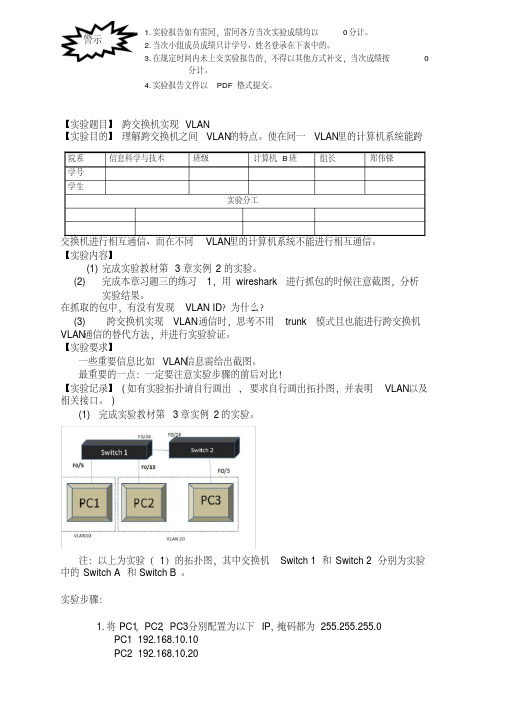
1.实验报告如有雷同,雷同各方当次实验成绩均以0分计。
2.当次小组成员成绩只计学号、姓名登录在下表中的。
3.在规定时间内未上交实验报告的,不得以其他方式补交,当次成绩按0分计。
4.实验报告文件以PDF 格式提交。
【实验题目】跨交换机实现VLAN【实验目的】理解跨交换机之间VLAN 的特点。
使在同一VLAN 里的计算机系统能跨交换机进行相互通信、而在不同VLAN 里的计算机系统不能进行相互通信。
【实验内容】(1)完成实验教材第3章实例2的实验。
(2)完成本章习题三的练习1,用wireshark 进行抓包的时候注意截图,分析实验结果。
在抓取的包中,有没有发现VLAN ID ?为什么?(3) 跨交换机实现VLAN 通信时,思考不用trunk 模式且也能进行跨交换机VLAN 通信的替代方法,并进行实验验证。
【实验要求】一些重要信息比如VLAN 信息需给出截图。
最重要的一点:一定要注意实验步骤的前后对比!【实验记录】(如有实验拓扑请自行画出,要求自行画出拓扑图,并表明VLAN 以及相关接口。
)(1) 完成实验教材第3章实例2的实验。
注:以上为实验(1)的拓扑图,其中交换机Switch 1和Switch 2分别为实验中的Switch A 和Switch B 。
实验步骤:1.将PC1,PC2,PC3分别配置为以下IP,掩码都为255.255.255.0PC1 192.168.10.10PC2 192.168.10.20院系信息科学与技术班级计算机B 班组长郑伟锋学号学生实验分工警示计算机网络实验报告PC3 192.168.10.302.实验前测试三台PC的连通性,记录情况。
PC1:PC2:PC3:2计算机网络实验报告3.交换机Switch A上创建Vlan10,并将0/5端口划分到Vlan10中,并进行验证测试。
PC1:PC2:PC3:4计算机网络实验报告4.交换机Switch A上创建Vlan20,并将0/15端口划分到Vlan20中,并进行验证测试。
跨交换机vlan实验报告
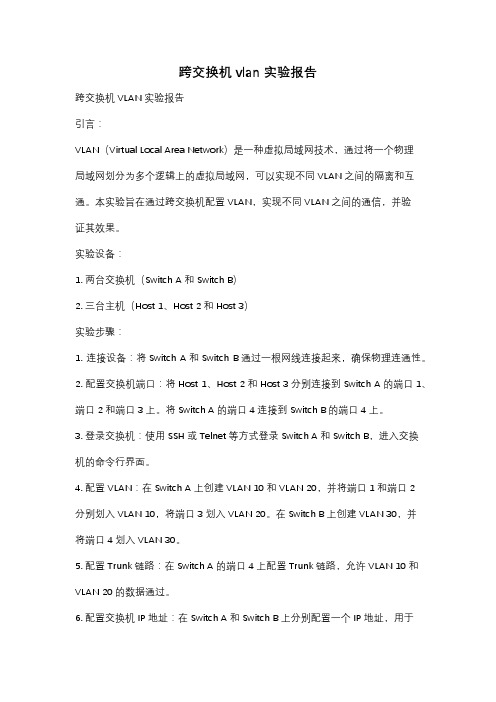
跨交换机vlan实验报告跨交换机VLAN实验报告引言:VLAN(Virtual Local Area Network)是一种虚拟局域网技术,通过将一个物理局域网划分为多个逻辑上的虚拟局域网,可以实现不同VLAN之间的隔离和互通。
本实验旨在通过跨交换机配置VLAN,实现不同VLAN之间的通信,并验证其效果。
实验设备:1. 两台交换机(Switch A和Switch B)2. 三台主机(Host 1、Host 2和Host 3)实验步骤:1. 连接设备:将Switch A和Switch B通过一根网线连接起来,确保物理连通性。
2. 配置交换机端口:将Host 1、Host 2和Host 3分别连接到Switch A的端口1、端口2和端口3上。
将Switch A的端口4连接到Switch B的端口4上。
3. 登录交换机:使用SSH或Telnet等方式登录Switch A和Switch B,进入交换机的命令行界面。
4. 配置VLAN:在Switch A上创建VLAN 10和VLAN 20,并将端口1和端口2分别划入VLAN 10,将端口3划入VLAN 20。
在Switch B上创建VLAN 30,并将端口4划入VLAN 30。
5. 配置Trunk链路:在Switch A的端口4上配置Trunk链路,允许VLAN 10和VLAN 20的数据通过。
6. 配置交换机IP地址:在Switch A和Switch B上分别配置一个IP地址,用于VLAN间的通信。
7. 配置主机IP地址:在Host 1、Host 2和Host 3上分别配置与所属VLAN相对应的IP地址。
8. 测试连通性:使用ping命令测试不同VLAN间的连通性。
实验结果:经过以上步骤的配置后,我们进行了以下实验测试:1. Host 1(属于VLAN 10)能够与Host 2(也属于VLAN 10)进行通信,可以互相ping通。
2. Host 1和Host 2无法与Host 3(属于VLAN 20)进行通信,ping命令无法ping通。
跨交换机实现VLAN实验报告

计算机网络实验报告——跨交换机实现VLAN实验目的跨交换机实现VLAN的划分与配置。
}一、实验器材•两台Switch2950交换机。
•四台PC机,其中一台装有超级终端仿真软件•一根console控制台电缆,直通双绞线若干,交叉双绞线若干。
-二、实验任务本实验实验拓扑图如下图,根据该网络结构所需网段,进行ip地址规划,需要完成的工作如下:1、实验设备的选择与调试。
2、根据实验拓扑图,连接端口。
<3、配置ip地址,并配置静态路由。
4、设置pc机IP地址及默认网关,并通过ping命令检查。
三、实验原理(1) 交换机基础配置^Interface range fa0/1-12 定义端口范围Switchport access vlan 将所定义的端口划分到vlanX(2) 常用命令1)改变状态命令|进入特权命令状态enable退出特权命令状态disable进入设置对话状态setup进入全局设置状态config terminal退出全局设置状态end%进入端口设置状态interface type slot/number进入子端口设状态interface type [point-to-point|multipoint]进入线路设置状态line type slot/number进入路由设置状态router protocol退出局部设置状态exit@2.)显示命令查看版本及引导信息show version查看运行设置show running-config 网络命令登录远程主机telnet hostname|IP_address网络侦测ping hostname|IP_address《5)基本设置命令全局设置config terminalPlease consult userdocumentation for configuring VTP/VLAN in config mode.xushiyao1(vlan)#vlan 2【VLAN 2 modified:xushiyao1(vlan)#vlan 2 name vlan2VLAN 2 modified:Name: vlan2xushiyao1(vlan)#vlan 3【VLAN 3 modified:xushiyao1(vlan)#vlan 3 name vlan3VLAN 3 modified:Name: vlan3xushiyao1(vlan)#exit~APPLY completed.Exiting....xushiyao1#xushiyao1#config tEnter configuration commands, one per line. End with CNTL/Z.【xushiyao1(config)#interface range fa0/1-12xushiyao1(config-if-range)#switchport access vlan 2xushiyao1(config-if-range)#no shutxushiyao1(config-if-range)#exitxushiyao1(config)#interface range fa0/13-24.xushiyao1(config-if-range)#switchport access vlan 3xushiyao1(config-if-range)#no shutxushiyao1(config-if-range)#exitxushiyao1(config)#exitxushiyao1#》%SYS-5-CONFIG_I: Configured from console by consolexushiyao1#copy run startDestination filename [startup-config]Building configuration...…[OK]xushiyao1#交换机2的设置:交换机2设置同交换机1,此处便不再重复·五、PC机IP地址设置及检验PC 上的配置为:xushiyao PC0:IP:子网掩码:xushiyaoPC1:IP:子网掩码:)xushiyaoPC2:IP:子网掩码:xushiyaoPC3:IP:子网掩码:全局通信测试:xushiyaoPC0:ping (检验本机ip协议)~结论:本机ip协议运作正常。
跨交换机实现vlan
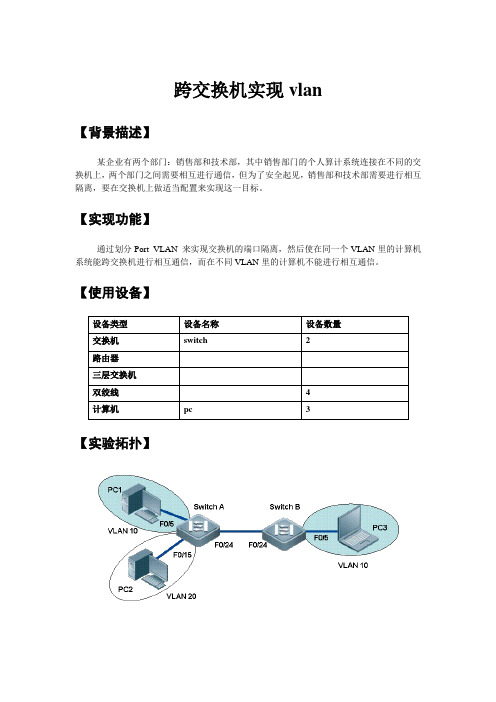
跨交换机实现vlan【背景描述】某企业有两个部门:销售部和技术部,其中销售部门的个人算计系统连接在不同的交换机上,两个部门之间需要相互进行通信,但为了安全起见,销售部和技术部需要进行相互隔离,要在交换机上做适当配置来实现这一目标。
【实现功能】通过划分Port VLAN 来实现交换机的端口隔离,然后使在同一个VLAN里的计算机系统能跨交换机进行相互通信,而在不同VLAN里的计算机不能进行相互通信。
【使用设备】【实验拓扑】【实现步骤】步骤1 在交换机switchA上创建vlan 10,并将f 0/5口端口划分到vlan10中SwitchA#configure terminalSwitchA(config)#vlan 10SwitchA(config-vlan)#exitSwitchA(config)#interface fastEthernet 0/5SwitchA(config-if)#switchport access vlan 10步骤2 在交换机switchA上创建vlan 20,并将f 0/15端口划分到vlan20中witchA(config)#vlan 20SwitchA(config-vlan)#exitSwitchA(config)#interface fastEthernet 0/15SwitchA(config-if)#switchport access vlan 20步骤3 把交换机switchA与交换机switchB相连的端口定义为Tag vlan 模式switchA(config)#interface fastEthernet 0/24switchA(config-if)#switchport mode trunkswitchB(config)#interface fastEthernet 0/24switchB(config-if)#switchport mode trunk步骤4 在交换机switchB上创建vlan 10,并将f 0/5端口划分到vlan10中SwitchB#configure terminalSwitchB(config)#vlan 10SwitchB(config-vlan)#exitSwitchB(config)#interface fastEthernet 0/5SwitchB(config-if)#switchport access vlan 10查看配置switchA#show vlanVLAN Name Status Ports---- -------------------------------- --------- -----------------------------1 default active Fa0/1 ,Fa0/2 ,Fa0/3 ,Fa0/4Fa0/6 ,Fa0/7 ,Fa0/8Fa0/9 ,Fa0/10,Fa0/11,Fa0/12Fa0/13,Fa0/14, Fa0/16Fa0/17,Fa0/18,Fa0/19,Fa0/20Fa0/21,Fa0/22,Fa0/23,Fa0/24Gi1/110 10 active Fa0/5 ,Fa0/2420 20 active Fa0/15, Fa0/24switchB#show vlanVLAN Name Status Ports---- -------------------------------- --------- -----------------------------1 default active Fa0/1 ,Fa0/2 ,Fa0/3 ,Fa0/4Fa0/6 ,Fa0/7 ,Fa0/8Fa0/9 ,Fa0/10,Fa0/11,Fa0/12Fa0/13,Fa0/14, Fa0/16Fa0/17,Fa0/18,Fa0/19,Fa0/20Fa0/21,Fa0/22,Fa0/23,Fa0/24Gi1/110 10 active Fa0/5 ,Fa0/24步骤5 验证pc1与pc3能相互通信,但pc2和pc3不能互相通信C:\Documents and Settings\Administrator>ping 172.16.8.6Pinging 172.16.8.6 with 32 bytes of data:Reply from 172.16.8.6: bytes=32 time<1ms TTL=64Reply from 172.16.8.6: bytes=32 time<1ms TTL=64Reply from 172.16.8.6: bytes=32 time<1ms TTL=64Reply from 172.16.8.6: bytes=32 time<1ms TTL=64Ping statistics for 172.16.8.6:Packets: Sent = 4, Received = 4, Lost = 0 (0% loss),Approximate round trip times in milli-seconds:Minimum = 0ms, Maximum = 0ms, Average = 0msC:\Documents and Settings\Administrator>ping 172.16.8.9Pinging 172.16.8.9 with 32 bytes of data:Request timed out.Request timed out.Request timed out.Request timed out.Ping statistics for 172.16.8.9:Packets: Sent = 4, Received = 0, Lost = 4 (100% loss),【注意事项】1.两台交换机之间的端口应该设置为tag vlan的传输。
- 1、下载文档前请自行甄别文档内容的完整性,平台不提供额外的编辑、内容补充、找答案等附加服务。
- 2、"仅部分预览"的文档,不可在线预览部分如存在完整性等问题,可反馈申请退款(可完整预览的文档不适用该条件!)。
- 3、如文档侵犯您的权益,请联系客服反馈,我们会尽快为您处理(人工客服工作时间:9:00-18:30)。
实验一:跨交换机实现VLAN
一、实验环境:Windows7操作系统的计算机;
Boson Netsim for CCNA v6.0
二、实验步骤;
pc1接到sw1的PA0/1,pc2接到sw1的PA0/2,pc3接到sw2的PA0/1,pc4接到sw2的PA0/2;sw1的PA0/12接到sw2的PA0/12作为主干道,配置如下:
(1) switch1的配置
Switch>enable
Switch#config terminal
Enter configuration commands, one per line. End with CNTL/Z.
Switch(config)#hostname switch1
switch1(config)#vlan 10
VLAN 10 added:
Name:VLAN0010
switch1(config)#interface fa 0/1
switch1(config-if)#switchport access vlan 10
switch1(config-if)#exit
switch1(config)#vlan 20
VLAN 20 added:
Name:VLAN0020
switch1(config)#inter fa 0/2
switch1(config-if)#switchport access vlan 20
switch1(config-if)#exit
switch1(config)#interface fa 0/12
switch1config-if)#switchport mode trunk
switch1(config-if)#end
(2) switch2的配置
Switch>enable
Switch#conf term
Enter configuration commands, one per line. End with CNTL/Z.
Switch(config)#hostname switch2
switch2config)#vlan 10
VLAN 10 added:
Name:VLAN0010
switch2(config)#interface fa 0/1
switch2config-if)#switchport access vlan 10
switch2(config-if)#exit
switch2(config)#vlan 20
VLAN 20 added:
Name:VLAN0020
switch2(config)#interface fa 0/2
switch2(config-if)#switchport access vlan 20
switch2(config-if)#exit
switch2(config)#interface fa 0/12
switch2(config-if)#switch mode trunk
switch2(config-if)#end
(3) 配置PC机的IP地址与网关
C:>win
PC1:192.168.100.1 255.255.255.0 GATEWAY 192.168.1.1
PC2:192.168.100.2 255.255.255.0 GATEWAY 192.168.1.1
PC3:192.168.100.3 255.255.255.0 GATEWAY 192.168.1.1
PC4:192.168.100.4 255.255.255.0 GATEWAY 192.168.1.1
三、最终配置列表:
switch1 switch2 PC1 PC2 PC3 PC4 子端口Vlan0010Vlan0010
子端口Vlan0020Vlan0020
主端口
Ethernet
ip
192.168.
100.1 192.168.
100.2
192.168.
100.3
192.168.
100.4
子网掩码
255.255.
255.0 255.255.
255.0
255.255.
255.0
255.255.
255.0
默认网关
192.168.
1.1 19
2.168.
1.1
192.168.
1.1
192.168.
1.1
四、结果分析:
在PC1上PING:
C:>ping 192.168.100.2
Pinging 192.168.100.2 with 32 bytes of data:
Request timed out.
Request timed out.
Request timed out.
Request timed out.
Request timed out.
Ping statistics for 192.168.100.2:
Packets: Sent = 5, Received = 0, Lost = 5 (100% loss),
Approximate round trip times in milli-seconds:
Minimum = 0ms, Maximum = 0ms, Average = 0ms
C:>ping 192.168.100.3
Pinging 192.168.100.3 with 32 bytes of data:
Reply from 192.168.100.3: bytes=32 time=60ms TTL=241
Reply from 192.168.100.3: bytes=32 time=60ms TTL=241
Reply from 192.168.100.3: bytes=32 time=60ms TTL=241
Reply from 192.168.100.3: bytes=32 time=60ms TTL=241
Reply from 192.168.100.3: bytes=32 time=60ms TTL=241
Ping statistics for 192.168.100.3: Packets: Sent = 5, Received = 5, Lost = 0 (0% loss),
Approximate round trip times in milli-seconds:
Minimum = 50ms, Maximum = 60ms, Average = 55ms
C:>ping 192.168.100.4
Pinging 192.168.100.4 with 32 bytes of data:
Request timed out.
Request timed out.
Request timed out.
Request timed out.
Request timed out.
Ping statistics for 192.168.100.4:
Packets: Sent = 5, Received = 0, Lost = 5 (100% loss),
Approximate round trip times in milli-seconds:
Minimum = 0ms, Maximum = 0ms, Average = 0ms
五、实验拓扑截图:
六、心得体会:
通过本次实验,掌握了交换机的配置过程,并顺利完成了跨交换机实现vlan的目标,但在实验过程中还是对命令不熟悉,有时会出错,今后要加强这方面的训练。
